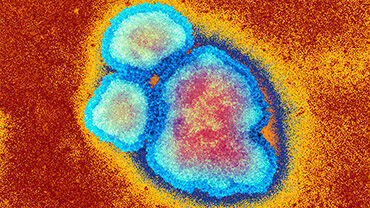Epidemiological update: Measles - monitoring European outbreaks, 14 July 2017
Romania has been experiencing a large outbreak of measles since February 2016. Cases continue to be reported despite ongoing response measures implemented at national level through reinforced vaccination activities. Between 1 January 2016 and 07 July 2017, Romania reported 7 647 measles cases, including 31 deaths. In 2016, several other EU/EEA countries reported measles outbreaks and an increase in the number of cases continues to be observed in 2017. Some previous and ongoing measles outbreaks in other EU/EEA countries have been epidemiologically linked to the current outbreak in Romania.

Update of the week
In addition to Romania, there is an update from the following EU/EEA countries: Finland, Bulgaria, Germany, Italy, Spain and the United Kingdom.
On 12 July 2017, WHO issued a statement that the ongoing measles outbreaks in the WHO European Region have caused 35 deaths in the past 12 months. The most recent fatality was a 6-year-old boy in Italy, where over 3300 measles cases and two deaths have occurred since June 2016. Several other countries have also reported outbreaks; according to national public health authorities, these have caused 31 deaths in Romania, one death in Germany and another in Portugal.
Epidemiological summary
EU/EEA countries with updates since last week:
Finland: On 27 June 2017, Finland reported a case of measles in an Italian citizen who worked at an international camp in Finland from 19 to 25 June 2017. On 4 July 2017, two cases were reported in unvaccinated siblings also linked to the international camp. On 13 July 2017 an additional case was detected belonging to the same transmission chain.
Bulgaria: Since the CDTR on 7 July 2017, 14 cases have been reported. Since the beginning of 2017 and as of 9 July, Bulgaria reported 162 cases. During the same time period in 2016 Bulgaria reported one case.
Germany: Since the CDTR on 7 July 2017, 14 cases have been reported. Since the beginning of 2017 and as of 5 July, Germany reported 780 cases. In the same time period in 2016, Germany reported 146 cases.
Italy: Since 7 July 2017, 155 cases were reported. Since the beginning of 2017 and as of 11 July, Italy reported 3 501 cases, including two deaths. Among the cases, 255 are healthcare workers. The median age is 27 years, 89% of the cases were not vaccinated and 6% received only one dose of vaccine.
Romania: There is an increase by 156 cases since the CDTR on 7 July 2017. Between 1 January 2016 and 7 July 2017, Romania reported 7 647 cases, including 31 deaths. Cases are either laboratory-confirmed or have an epidemiological link to a laboratoryconfirmed case. Infants and young children are the most affected group. Forty-one of the 42 districts have reported cases. Timis, in the western part of the country closest to the border with Serbia, is the most affected district with 1 174 cases. Vaccination activities are ongoing in order to cover communities with suboptimal vaccination coverage.
Spain: Since the CDTR on 7 July 2017 one case was reported. From the beginning of 2017 and as of 9 July, Spain reported 138 measles cases.
United Kingdom: Since the beginning of June 2017 and as of 12 July 2017, Public Health Wales reported eight cases related to an outbreak affecting the Newport and Torfaen areas. On 12 July 2017, Public Health Wales reported three new cases in children who are too young for vaccination. Two of these cases caught measles from another patient while attending the accident and emergency department at a hospital in Newport on the evening of 14 June. During the first three months of 2017, England reported 17 confirmed cases, compared with 37 between October and December 2016.
On 6 July 2017, Public Health Agency (PHA) of Northern Ireland has reported small number of cases. Scotland has reported no cases so far this year.
In addition to the updates listed above ECDC produces a monthly measles and rubella monitoring report with surveillance data provided by the member states through TESSy. The last report was published on 11 July 2017 with data up to 31 May 2017.
ECDC assessment
Measles outbreaks continue to occur in EU/EEA countries. As of 12 July 2017, the ongoing measles outbreaks in the WHO European Region have caused 35 deaths in the past 12 months. The most recent fatality was a 6-year-old boy in Italy, where over 3300 measles cases and two deaths have occurred since June 2016. Several other countries have also reported outbreaks; according to national public health authorities, these have caused 31 deaths in Romania, one death in Germany and another in Portugal.
There is a risk of spread and sustained transmission in areas with susceptible populations. The national vaccination coverage remains less than 95% for the second dose of MMR in the majority of EU/EEA countries. The progress towards elimination of measles in the WHO European Region is assessed by the European Regional Verification Commission for Measles and Rubella Elimination (RVC). Member States of the WHO European Region are making steady progress towards the elimination of measles. At the fifth meeting of the RVC for Measles and Rubella in October 2016, of 53 countries in the WHO European Region, 24 (15 of which are in the EU/EEA) were declared to have reached the elimination goal for measles, and 13 countries (nine in the EU/EEA) were deemed to have interrupted endemic transmission for between 12 and 36 months, meaning they are on their way to achieving the elimination goal. However, six EU/EEA countries were judged to still have endemic transmission: Belgium, France, Germany, Italy, Poland and Romania.
ECDC link: Measles page
Actions
All EU/EEA countries report measles cases on a monthly basis to ECDC and these data are published every month. Since 10 March 2017, ECDC has been reporting on measles outbreaks in Europe on a weekly basis through epidemic intelligence activities. ECDC published a rapid risk assessment on 6 March.






